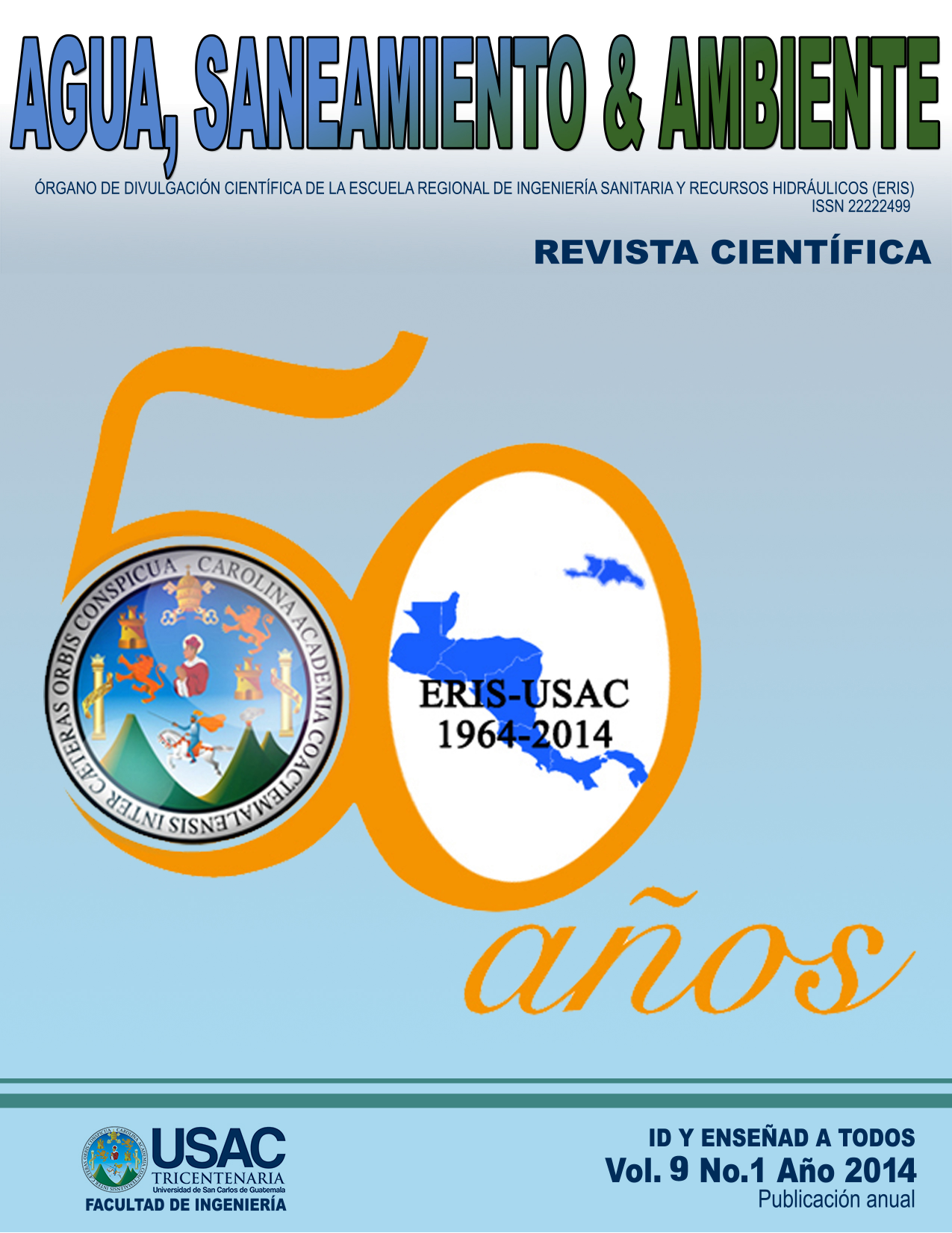VARIACIÓN ESTACIONAL DE LA CALIDAD DEL AGUA DEL RÍO CACHIL, CON ÉNFASIS EN LA UTILIZACIÓN DEL RECURSO HÍDRICO SUPERFICIAL, SALAMÁ, BAJA VERAPAZ
DOI:
https://doi.org/10.36829/08ASA.v9i1.1460Keywords:
Surface water, water quality indices, basin, water testing, water quality, water pollution, integrated water resources management, irrigation, seasonal variation, indices of basins, BOD, dissolved oxygen, whatershedAbstract
This article has generated information on seasonal variations in water quality of the river that supplies drinking water to the population of Salama, determining the quality indices of the Cachil river that belongs to the watershed of the same name, it is located in the dry corridor in the village of Salama of the department of Baja Verapaz. This paper emphasizes the analysis the variation of water quality from the pollution present in the rainy season calculating the monthly quality indices, through which were identified variations caused by water shortages due to low rainfall and the increased use of water for irrigation in the dry season and increased suspended material from erosion in the rainy season. To determine the variation of water quality there were established four sampling points, one located in the upper part of the watershed (Llano Largo), the second in the middle (El Carmen), the third in the lower (Cachil) and fourth in the catchment area of the treatment plant. Monthly samples were made where in situ parameters were taken and parameters that were analyzed in the laboratory, information that allowed the calculation of water quality indices through WQINSF, which assigns values of importance to each of the variables in which it is based, so that the index can be determined as: (Krendel and Novontny, 1980), where Wi: denotes the importance or weighting factor of the variable (i) with respect to the other variables that make up the index, and weighted between 0 and 1, so that the total is equal to one. Indices used to define the quality variation is mainly due to the levels of electrical conductivity, nitrates, phosphates, dissolved oxygen, total solids, total and fecal coliforms that showed a marked seasonal variation. Cachil river waters generally are classified into quality indices for the rainy season for consumption are between the ranges (40.21 to 60.21) with indices of medium to poor quality, with these characteristics the water could be used with purification treatments. And for agricultural use it is within the same range which could be used for most crops and in some months it has to be treated for irrigation use. It is important to underline that the data could be obtained associating physico-chemical and bacteriological parameters (temperature, dissolved solids, turbidity, phosphates, % oxygen saturation, pH, nitrates, fecal coliform and DBO). It was determined that the morphometry of the watershed is elongated, with a low density of drains that reflects a poorly drained area with a very low hydrological response, with an average slope of 43.21 % and a main channel slope of 5.724 %. Also it was observed that the flow rate decreases considerably from February to April (minimum flow rate is 0. 001 m3 /s at February and at the lower part of the watershed) and August is the maximum flow rate (maximum flow rate 2.33 m3 /s at the El Carmen basin midpoint).
Downloads
References
Aguinaga, S. (1996). Manual de procedimientosanalíticos de aguas y efluentes. Ministerio deVivienda, Ordenamiento Territorial y Medio yAmbiente. Extraído el 15 de enero del 2011 desde:http://www.google.com.gt/#hl=es&sugexp=kjrmc&cp=16&gs_id=1p&xhr=t&q=dinama+manual&pf=p&sclient=psy-ab&source=hp&pbx=1&oq=dinama+manual+de&aq=f&aqi=&aql=&gs_sm=&gs_upl=&bav=on.2,or.r_gc.r_pw.,cf.osb&fp=c6e5e95adbd1824d&biw=948&bih=453
Basterrechea,M. (2009). Línea base sobre el Estado delos recursos naturales en 6 cuencas en losmunicipios del Corredor Seco de Baja Verapaz,Guatemala. Asesoría Manuel Basterrechea yAsociados, S.A. 412pp.
Centro de estudios ambientales. (2007). ProyectoInstitucionalidad local para el manejo de bosque yagua en comunidades indígenas Sitio FincaPacalaj y Sitio bosque El Gigante Guatemala.Universidad del Valle de Guatemala. 164 pp.
Consejo Nacional de Áreas Protegidas. Departamentode vida silvestre. (2007). Monitoreo de calidad deagua. Procedimiento operativo. Extraído el 14 deoctubre de 2011 desdehttp://www.chmguatemala.gob.gt/informacion/monitoreo-de-biodiversidad/automatizado/Procedimiento%20Operativo%20Calidad%20de%20Agua.pdf
Córdoba Núñez, A. (2002). Calidad de agua y surelación con los usos actuales en la Subcuenca delrío Jucuapa. Magalpa, Nicaragua. Trabajo de gradode maestría, Centro Agronómico Tropical deInvestigación y Enseñanza. CATIE. Turrialba.Costa Rica. Extraído el 12 de octubre de 2011desde http://www.portalcuencas.net/Virtual_Library/Files/198.pdf
Jiménez, M. (2006) Análisis comparativo deIndicadores de calidad de agua Superficial.Escuela de Geociencia y Medio Ambiente. Número14. Medellín. Colombia. Extraído el 15 de octubredel 2011 desdehttp://www.revistas.unal.edu.co/index.php/arh/article/viewFile/9331/9974
Moraña, L., Salusso, M. García, M. (2002) Evaluaciónde la calidad del agua en la cuenca del ríoGrande (Alta Cuenca Del Bermejo, Jujuy). Rev.Biol. Trop. Universidad Nacional de Salta.Buenos Aires, Argentina.
Ramírez, J. (2003). Línea base en calidad de aguapara la cuenca del río Valdivia. Trabajo de gradode Licenciatura, Universidad de Santiago de Chile.Chile. Extraído el 25 de septiembre de 2011 desdehttp://www.digeo.cl/doc/Ramirez_Pavez_Jeanett.pdf
Reynoso, L. Andriulo, A. (2009). Estado actual de lacalidad del agua en la cuenca del ArroyoPergamino. Extraído el 15 de enero del 2010 desdehttp://www.inta.gov.ar/pergamino/info/documentos/2009/Calidad_agua_Cuenca_APerg_jun09.pdf
Saravia, P. (2009). Contaminación del agua. Facultadde Ingeniería, Universidad de San Carlos deGuatemala. Guatemala. 95pp.
Torres. F. (2009). Desarrollo y Aplicación de un Índicede Calidad de Agua para ríos en Puerto Rico.Trabajo de grado de maestría. Universidad dePuerto Rico. Puerto Rico
Unión Mundial para la Naturaleza (UICN). (2005). Plande monitoreo para sistemas de abastecimiento delrío o nacimiento en el sur de Ahuchapan, ElSalvador, C.A. Extraído el 25 de septiembre de2011 desde: ecobook.net/action/file/download?file_guid= 885.
Universidad de Pamplona. Colombia. (n.d.) Índices decalidad (ICAs) y de contaminación (ICOs) del aguade importancia Mundial. Capítulo III. Extraído el 10de octubre de 2011 desdehttp://www.unipamplona.edu.co/unipamplona/portalIG/home_10/recursos/general/pag_contenido/libros/06082010/icatest_capitulo3.pdf
Valencia.J.L. (2007). Estudio Estadístico de la calidaddel agua en la cuenca hidrográfica del río Ebro.Tesis Doctoral. Universidad Politécnica de Madrid.338 pag. Extraído el 15 de enero del 2011 desdeen: http://oa.upm.es/454/1/JOSE_LUIS_VALENCIA_DELFA.pdf
Downloads
Published
How to Cite
Issue
Section
License

This work is licensed under a Creative Commons Attribution-NonCommercial-ShareAlike 4.0 International License.







